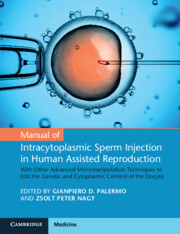 Manual of Intracytoplasmic Sperm Injection in Human Assisted Reproduction
Manual of Intracytoplasmic Sperm Injection in Human Assisted Reproduction Published online by Cambridge University Press: 02 December 2021
There is no doubt that intracytoplasmic sperm injection (ICSI) has been a major breakthrough in treating male infertility, accounting for 70–80% of all the cycles performed worldwide. Surprisingly, there were very few animal studies conducted before the first babies were born, in part because of technical challenges that were experienced in most animal systems. Technological advancements were required to develop appropriate animal models for assessing the safety of ICSI. These studies identified many cytoskeletal changes that occurred in the oocyte cytoplasm after ICSI versus natural conception or even IVF, raising concerns about the long-term health of ICSI offspring. This chapter summarizes the animal models that have contributed to our understanding of the cellular and molecular aspects of ICSI, as well as providing models to investigate both the developmental origins of adult disease and transgenerational implications as they relate to ICSI.
To save this book to your Kindle, first ensure [email protected] is added to your Approved Personal Document E-mail List under your Personal Document Settings on the Manage Your Content and Devices page of your Amazon account. Then enter the ‘name’ part of your Kindle email address below. Find out more about saving to your Kindle.
Note you can select to save to either the @free.kindle.com or @kindle.com variations. ‘@free.kindle.com’ emails are free but can only be saved to your device when it is connected to wi-fi. ‘@kindle.com’ emails can be delivered even when you are not connected to wi-fi, but note that service fees apply.
Find out more about the Kindle Personal Document Service.
To save content items to your account, please confirm that you agree to abide by our usage policies. If this is the first time you use this feature, you will be asked to authorise Cambridge Core to connect with your account. Find out more about saving content to Dropbox.
To save content items to your account, please confirm that you agree to abide by our usage policies. If this is the first time you use this feature, you will be asked to authorise Cambridge Core to connect with your account. Find out more about saving content to Google Drive.